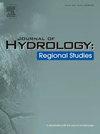SWOT mission enables high-precision and wide-coverage lake water levels monitoring on the Tibetan Plateau
IF 5
2区 地球科学
Q1 WATER RESOURCES
引用次数: 0
Abstract
Study region
The Tibetan Plateau (TP) is a high-altitude region characterized by harsh environmental conditions and limited accessibility, making the monitoring of its numerous lakes a significant challenge. This region is crucial for hydrological studies, and its numerous lakes play an important role in regional water dynamics and climate change research.
Study focus
This study evaluates the applicability and accuracy of Surface Water and Ocean Topography (SWOT) satellite data in monitoring lake water levels across the TP. The study compares SWOT-derived lake levels with data from the Ice, Cloud, and Land Elevation Satellite-2 (ICESat-2), instead of relying on in situ measurements.
New hydrological insights for the region
Based on SWOT data, lake water levels for 1919 lakes were successfully extracted, covering approximately 99 % of lakes larger than 0.2 km² and filling observation gaps in around 800 lakes compared to traditional altimetry satellites. Validation against ICESat-2 data demonstrated high consistency, with an average bias of −0.01 ± 0.13 m and a mean absolute error (MAE) of less than 0.1 m. SWOT outperformed other radar altimeters in monitoring lake levels when compared to ICESat-2. Furthermore, by integrating SWOT data with other altimetry-derived lake level products, we created high-frequency time series data for 12 lakes, which showed strong correlations with the DAHITI and Hydroweb datasets. These results highlight SWOT's potential for global lake monitoring, offering new opportunities for water resource management and climate change research.
SWOT任务实现了青藏高原湖泊水位的高精度、大范围监测
青藏高原是一个高海拔地区,环境条件恶劣,可达性有限,对其众多湖泊的监测是一个重大挑战。该地区是水文研究的重要区域,其众多湖泊在区域水动力学和气候变化研究中发挥着重要作用。本研究评估了地表水和海洋地形(SWOT)卫星数据在整个青藏高原湖泊水位监测中的适用性和准确性。该研究将swot得出的湖泊水位与冰、云和陆地高程卫星-2 (ICESat-2)的数据进行了比较,而不是依赖于原位测量。基于SWOT数据,成功提取了1919个湖泊的湖泊水位,覆盖了约99% %大于0.2 km²的湖泊,填补了约800个湖泊与传统测高卫星相比的观测空白。对ICESat-2数据的验证显示出高度的一致性,平均偏差为−0.01 ± 0.13 m,平均绝对误差(MAE)小于0.1 m。与ICESat-2相比,SWOT在监测湖泊水位方面优于其他雷达高度计。此外,通过将SWOT数据与其他湖泊高度数据相结合,我们创建了12个湖泊的高频时间序列数据,这些数据与DAHITI和Hydroweb数据集具有很强的相关性。这些结果突出了SWOT在全球湖泊监测中的潜力,为水资源管理和气候变化研究提供了新的机会。
本文章由计算机程序翻译,如有差异,请以英文原文为准。
求助全文
约1分钟内获得全文
求助全文
来源期刊

Journal of Hydrology-Regional Studies
Earth and Planetary Sciences-Earth and Planetary Sciences (miscellaneous)
CiteScore
6.70
自引率
8.50%
发文量
284
审稿时长
60 days
期刊介绍:
Journal of Hydrology: Regional Studies publishes original research papers enhancing the science of hydrology and aiming at region-specific problems, past and future conditions, analysis, review and solutions. The journal particularly welcomes research papers that deliver new insights into region-specific hydrological processes and responses to changing conditions, as well as contributions that incorporate interdisciplinarity and translational science.
 求助内容:
求助内容: 应助结果提醒方式:
应助结果提醒方式:


